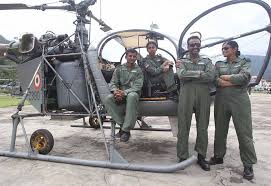SOURCE: TNN
India may not allow them to fly fighter jets, when even countries like Pakistan do, but women IAF pilots are proving their mettle by flying high-risk missions on their helicopters to rescue stranded people in flood-ravaged Uttarakhand.
Meet Squadron leader Khushboo Gupta, who has already flown over 55 sorties in her Cheetah helicopter to the Kedarnath valley and beyond. “The experience is very challenging… flying at 11,500 feet altitude is not easy, often with bad weather and poor visibility. But we in the IAF are trained for such missions and keep flight safety on the top of our minds,” Gupta told TOI.
Flight Lieutenant Tanya Srinivas, with barely two-and-a-half years of service as an “air warrior”, is also gung-ho about the tasks ahead. “I have flown earlier in deserts, plains and hills. But this operation is specially challenging… IAF gives you the opportunity to help people in emergency situations,” she said.
Interestingly, the husbands of both the women are also helicopter pilots engaged in the ongoing Operation Rahat, the largest airlift of people and relief supplies undertaken by the IAF.
But while Khushboo and Tanya are operating their Cheetahs from Gauchar, their husbands Squadron Leaders S K Pradhan and Vikram Thiagaraman, respectively, are flying their larger Mi-17 helicopters from Dehradun as their base.
“It’s good both of us can contribute to the massive effort underway… the devastation is staggering and on a very big scale,” said Khushboo, who was commissioned into IAF six years ago. The unfortunate crash of a Mi-17-V5 helicopter north of Gaurikund on Tuesday afternoon is unlikely to dampen this robust enthusiasm despite the loss of friends and comrades.
Acting both as the pilot and co-pilot as per mission requirements, Khushboo has evacuated over 90 people from Jungle Chetti and other places. “We are operating in areas where bigger helicopters like Mi-17s cannot go. Landing the Cheetah in restricted spaces is very demanding. But it’s very satisfying and rewarding to see smiles on the faces of the people we rescue,” she said.
Given the overwhelming male-dominant environs of the armed forces, “women air warriors” like Khushboo and Tanya have often beaten their male counterparts in military aviation skills to reach where they have by the sheer dint of hard work and enthusiasm.
While women pilots are not yet allowed to fly fighter jets, they have been taking to the skies in helicopters and transport aircraft in IAF for over a decade now. Of the around 1,000 women officers in IAF as of now, around 80 are pilots.
Incidentally, the ageing Cheetah and Chetak helicopters of the armed forces were first inducted in the 1970s based on the design of French ‘Alouettes’ and ‘Lama SA-315′. Over 250 of them were subsequently manufactured under licence by Hindustan Aeronautics Ltd (HAL) till the 1980s. “These helicopters do not have modern avionics and navigational aids, nor advanced electrically-driven instruments. So, it’s basically visual flying by the-seat-of-your-pants,” said another pilot.

No comments:
Post a Comment